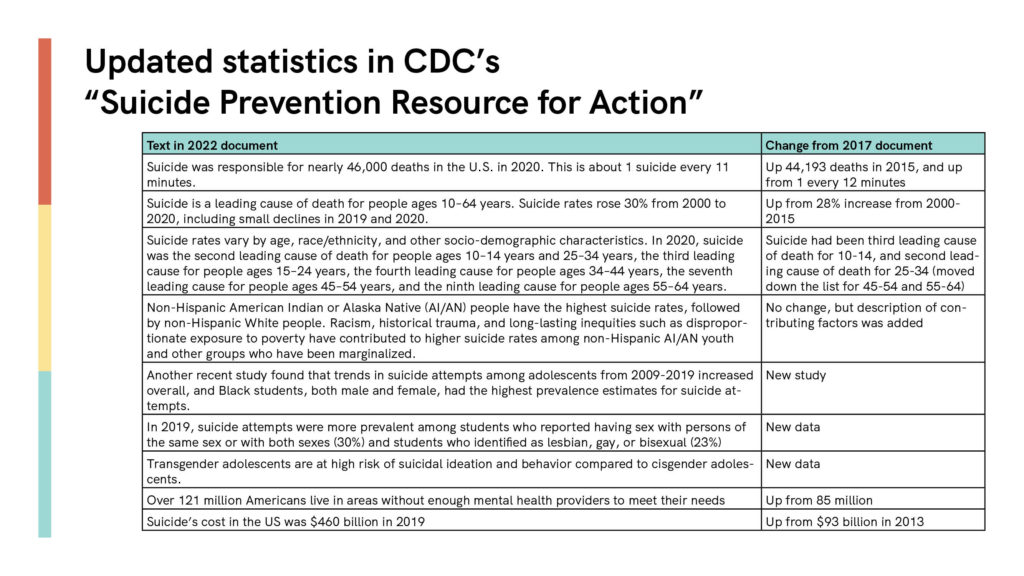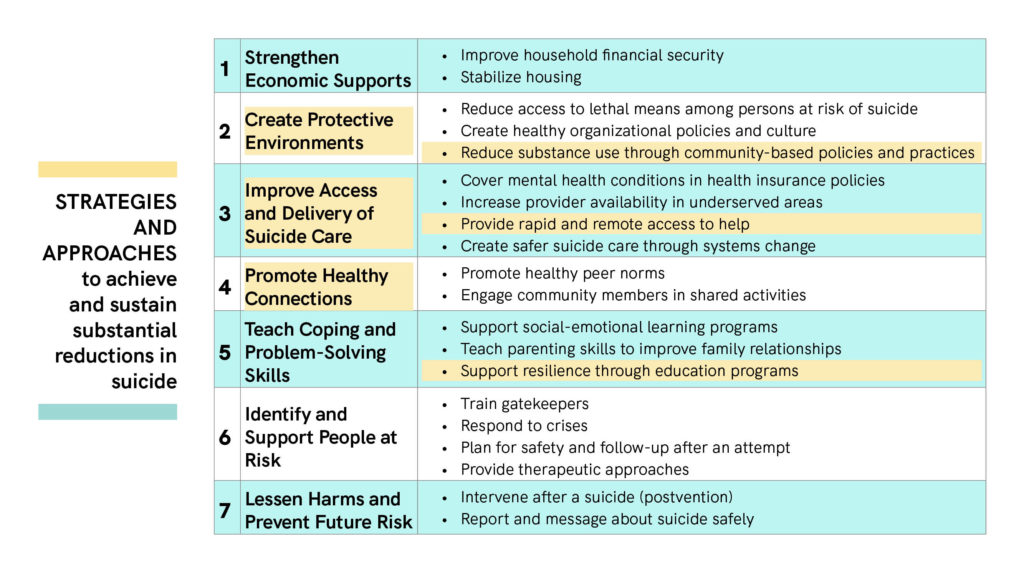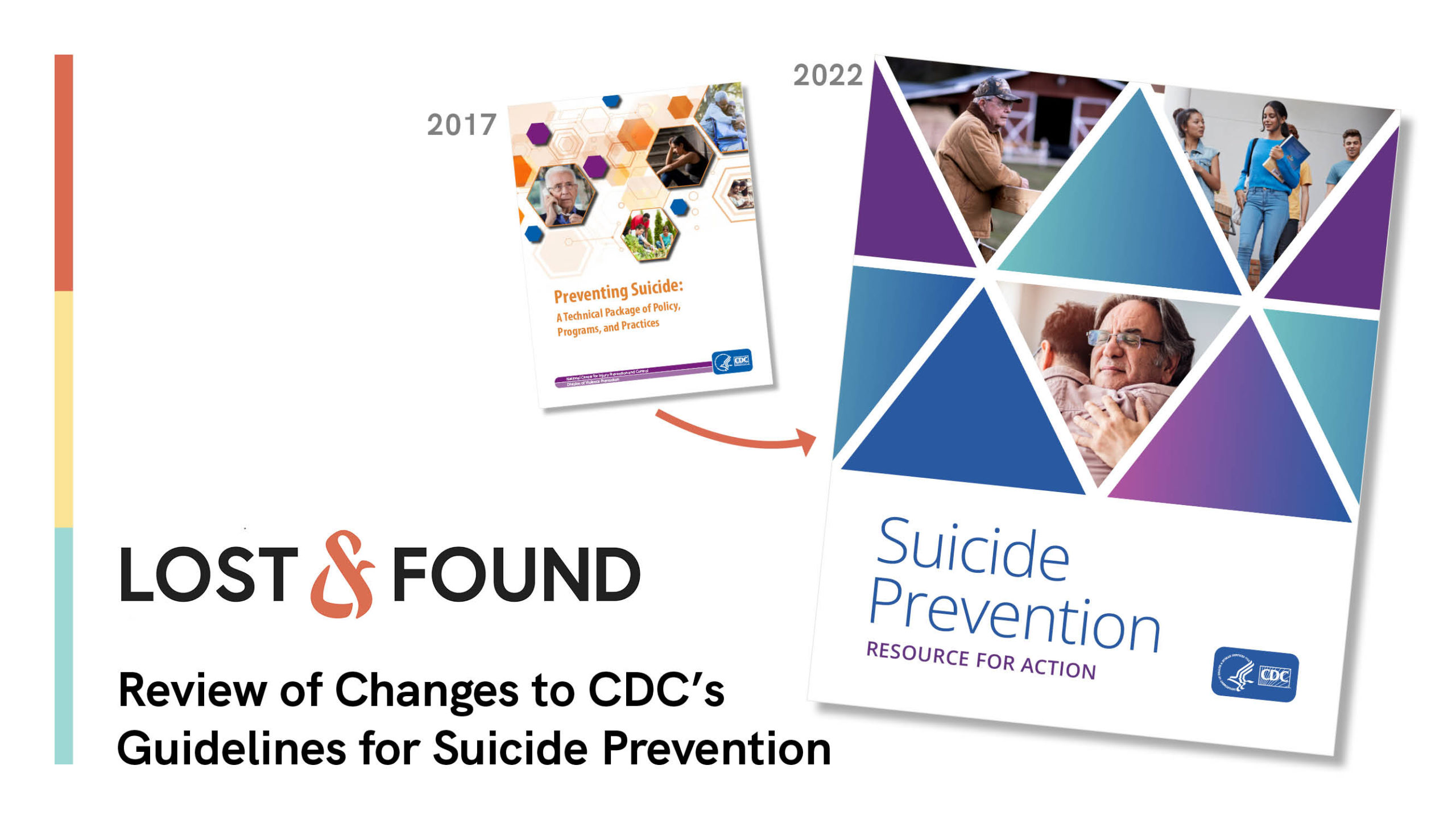CDC updates its guidance for suicide prevention
The Centers for Disease Control and Prevention updated its guidance for those working in suicide prevention late last year.
This document serves as a foundational piece of Lost&Found’s approach to suicide prevention work. For example, Lost&Found’s Campus Resilience Index measures how well a campus is achieving the CDC’s recommended strategies and approaches. The CDC guidance is intended to present the best available evidence for strategies that prevent suicide and has been reviewed by many experts in the field.
Much of the document stayed the same as the initial release of the document from 2017. It still starts from a public health approach, as described in the document: “The public health approach uses data to define the problem, science to determine what works for prevention, and widespread adoption of effective programs, practices, and policies with a particular focus on upstream prevention that seeks to prevent suicide risk in the first place.”
The seven strategies did not change; each of the strategies has 2-4 approaches to achieve that strategy.
There are some key differences, however, between the old document and the new one.
The 2017 guidance was published with the title “Preventing Suicide: A Technical Package of Policy, Programs, and Practices.” The updated document has a new title: “Suicide Prevention Resource for Action.”
The message “Suicide is preventable” was moved to the top of the document: “Suicide Can Be Prevented: Like most public health problems, suicide is preventable. The National Center for Injury Prevention and Control’s vision of ‘No lives lost to suicide’ relies on implementing a comprehensive public health approach to prevention.” (page 11)
A number of statistics in the document were updated. Most of them had gotten worse since 2017. One improvement from 2017 was that suicide had moved down as a leading cause of death for those ages 45-54 and 55-64, in part because COVID-19 moved up the list as a cause of death for those age groups. Some of the updated statistics are summarized in the chart below.

Updated statistics in CDC’s
“Suicide Prevention Resource for Action”
Text in 2022 document |
Change from 2017 document |
|
Suicide was responsible for nearly 46,000 deaths in the U.S. in 2020. This is about 1 suicide every 11 minutes. |
Up 44,193 deaths in 2015, and up from 1 every 12 minutes |
|
Suicide is a leading cause of death for people ages 10–64 years. Suicide rates rose 30% from 2000 to 2020, including small declines in 2019 and 2020. |
Up from 28% increase from 2000-2015 |
|
Suicide rates vary by age, race/ethnicity, and other socio-demographic characteristics. In 2020, suicide was the second leading cause of death for people ages 10–14 years and 25–34 years, the third leading cause for people ages 15–24 years, the fourth leading cause for people ages 34–44 years, the seventh leading cause for people ages 45–54 years, and the ninth leading cause for people ages 55–64 years. |
Suicide had been third leading cause of death for 10-14, and second leading cause of death for 25-34 (moved down the list for 45-54 and 55-64) |
|
Non-Hispanic American Indian or Alaska Native (AI/AN) people have the highest suicide rates, followed by non-Hispanic White people. Racism, historical trauma, and long-lasting inequities such as disproportionate exposure to poverty have contributed to higher suicide rates among non-Hispanic AI/AN youth and other groups who have been marginalized. |
No change, but description of contributing factors was added |
|
Another recent study found that trends in suicide attempts among adolescents from 2009-2019 increased overall, and Black students, both male and female, had the highest prevalence estimates for suicide attempts. |
New study |
|
In 2019, suicide attempts were more prevalent among students who reported having sex with persons of the same sex or with both sexes (30%) and students who identified as lesbian, gay, or bisexual (23%) |
New data |
|
Transgender adolescents are at high risk of suicidal ideation and behavior compared to cisgender adolescents. |
New data |
|
Over 121 million Americans live in areas without enough mental health providers to meet their needs |
Up from 85 million |
|
Suicide’s cost in the US was $460 billion in 2019 |
Up from $93 billion in 2013 |
The 2022 document places a new emphasis on the cumulative effect of both risk factors as well as protective factors on a person’s suicide risk:
- “Research indicates that suicide risk varies as a result of the number and intensity of key risk and protective factors experienced.” (page 13)
- “The effects of ACEs (Adverse Childhood Experiences) are often cumulative. Experiencing more ACEs is associated with greater risk for future poor outcomes when compared to people with fewer ACEs.” (page 15)
The new document also now includes a mention of the increased risk during transition periods: “Transition periods are also associated with higher risk of suicide. This includes transitions from … high school to college …” (page 12)

There were two subtle changes to the seven strategies listed in the document. While the strategies stayed the same, the order of those strategies changed, as two strategies switched places in the list: “Create Protective Environments” moved up to the No. 2 spot, and “Improve Access and Delivery of Suicide Care” moved down to No. 3. The strategies are listed in order of broadest reach (more people) to more targeted reach (fewer people), which would suggest that experts in the field believe that more people can be affected by creating protective environments than improving suicide care. Also, the word “Healthy” was added to the fourth strategy on the list to make it “Promote Healthy Connections.”
Three approaches were added to the list of how the strategies could be achieved.
- Under the strategy “Create Protective Environments,” the approach “Reduce substance use through community-based policies and practices” was added.
- Under the strategy “Improve Access and Delivery of Suicide Care,” the approach “Provide rapid and remote access to help” was added. This approach included the mention of apps that can be used as part of treatment.
- Under the strategy “Teach Coping and Problem-Solving Skills,” the approach “Support resilience education through education programs” was added. This is relevant to Lost&Found’s resilience education work, including the Advocates program.
Here are a few other changes, in brief:
- The document puts a new emphasis on the idea that “approaches to put time and space between lethal means and suicidal individuals may help save lives.”
- There is a new mention of substance use disorders and suicide risk being associated.
- COVID-19’s effect on mental health is mentioned.
- Reducing stigma is newly mentioned as a potential outcome of several of the recommended approaches.
- There is a new emphasis on multi-sector partnerships and strategic planning among multiple sectors.
The document also includes new evidence for most of the strategies and approaches listed in the document.
Lost&Found staff members reviewed the changes in the document during their all-staff retreat on Jan. 26 and discussed how they can continue to build upon these guidelines in their work.

